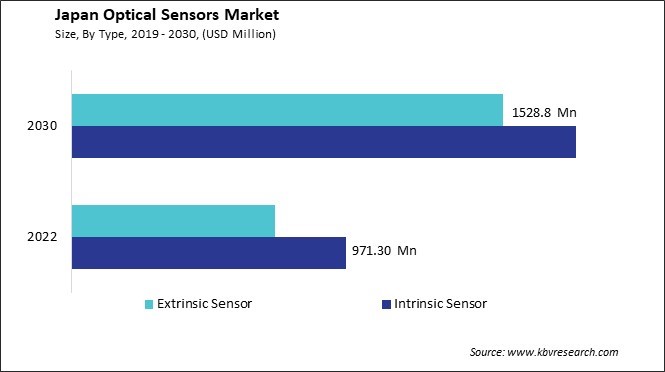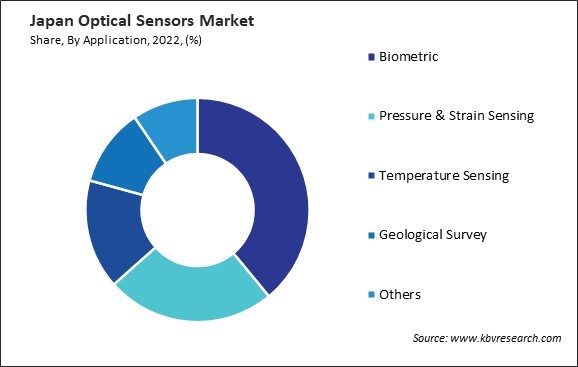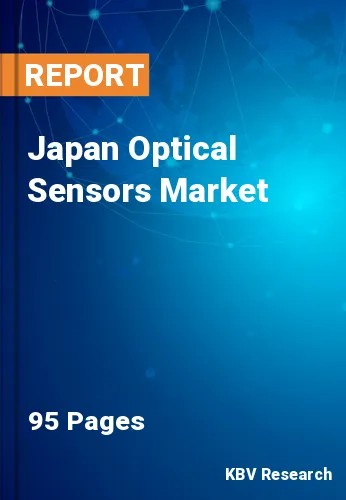The Japan Optical Sensors Market size is expected to reach $3.3 Billion by 2030, rising at a market growth of 8.9% CAGR during the forecast period.
The optical sensors market in Japan has witnessed substantial growth in recent years, driven by advancements in technology, increasing demand across various industries, and the country's commitment to innovation. Japan is forefront of incorporating optical sensors in communication networks through photonics technology. Optical sensors are crucial for high-speed data transmission, and Japan's advancements in photonics contribute to the development of efficient and reliable communication infrastructure.

While the COVID-19 pandemic presented numerous challenges globally, it also positively impacted the optical sensors market in Japan. The increased focus on remote work and telemedicine, driven by the pandemic, accelerated the demand for optical sensors in devices such as webcams, biometric authentication systems, and health monitoring wearables. Japanese companies responded swiftly to the changing landscape, adapting their technologies to meet the evolving needs of a socially distanced world.
Japan's automotive industry has been a key driver for the optical sensors market, with the increasing integration of sensors in advanced driver-assistance systems (ADAS) and other safety features. The push towards electric vehicles and autonomous driving has further fueled the demand for optical sensors that provide accurate and real-time data for navigation, obstacle detection, and overall vehicle control.
According to the Japan Automobile Dealers Association (JADA), sales of new electric vehicles in 2020 reached close to 1.4 million. This surge represented a substantial increase, as new electric vehicles comprised 36.2% of total new car sales, up from 35.2% in 2019. Notably, 97.8% of the newly sold electric vehicles in 2020 were HEVs, followed by PHEVs 1.1%, BEVs 1.1% and FECVs 0.1%. This surge in electric vehicle adoption underscores a significant expansion in Japan's electric vehicle sector and presents promising growth opportunities in related industries such as optical sensors.
Japan has emerged as a global leader in advanced manufacturing and robotics, significantly impacting the optical sensors market. The country's engineering heritage, rooted in the concept of "monozukuri" or craftsmanship, emphasizes the pursuit of perfection in manufacturing. This cultural ethos has been seamlessly integrated with modern technologies, contributing to developing highly reliable and precise optical sensors.
In recent years, Japanese manufacturers have increasingly integrated robotics into their production processes to enhance efficiency and ensure high-quality output. This shift towards automation is particularly evident in the optical sensor sector, where precision is paramount. Advanced manufacturing techniques, such as 3D printing and CNC machining, have become staples in Japanese production facilities, enabling the rapid and cost-effective production of intricate optical sensor components. The robotics revolution in Japan has not only streamlined manufacturing but has also played a pivotal role in research and development. Collaborations between robotics experts and optical sensor engineers have led to the creation of innovative sensor technologies.
According to the International Trade Administration, in 2022, 45% of all industrial robots in the world were originally produced or designed by companies in Japan. The remarkable growth in this industry was evident as orders for industrial robots from Japanese manufacturers achieved a record-breaking $7.35 billion, marking a 1.6% increase from the previous year. Moreover, production in Japan surged by 5.6%, setting a new record in the field. In 2021, Japan boasted an impressive ratio of 631 robots for every 10,000 humans in the manufacturing sector, reflecting the nation's dedication to harnessing the potential of automation and robotics across various industries.
Furthermore, Japan's emphasis on miniaturization aligns with the growing demand for compact and efficient optical sensors. Miniaturized sensors find applications in smartphones, cameras, and medical equipment. Japanese companies, leveraging their expertise in microtechnology, have excelled in producing compact optical sensors that deliver high performance in a small form factor. Thus, Japan's integration of craftsmanship with modern technologies, particularly robotics and advanced manufacturing, has positioned it as a global leader in precision optical sensors.
In Japan, the optical sensors market is witnessing a remarkable surge in demand for pressure and strain sensing technologies, marking a transformative phase in the country's technological landscape. Japan's healthcare industry contributes to the growing demand for these sensors. Pressure-sensing optical devices are utilized in medical applications, including wearable health monitoring devices and diagnostic equipment. The precision offered by these sensors ensures accurate data collection, which is vital for monitoring patients' health conditions and improving the effectiveness of medical diagnoses.
According to the International Trade Administration, Japan's burgeoning healthcare IT industry is poised for substantial growth, with wearable healthcare equipment and service systems projected to attain a value of 16 billion by 2025. The ratio of online medical care, electronic health records, and wearable technology is limited to 7%, 9%, and 9%, respectively. This surge aligns with Japan's increasing integration of advanced technologies, including optical sensors, in developing innovative healthcare solutions such as smart wearable devices and online monitoring services for enhanced patient care and well-being.
In the manufacturing sector, a prime example of Japan's embrace of pressure and strain sensing in optical sensors is evident in the production processes of precision machinery. Companies like Fanuc and Okuma, pioneers in industrial automation and machine tool manufacturing, utilize these sensors to enhance the precision of their machines. For instance, pressure-sensing optical devices are integrated into CNC (Computer Numerical Control) machines, ensuring meticulous control over cutting processes and contributing to the production of high-quality components. Hence, Japan's surge in demand for pressure and strain sensing technologies, witnessed across healthcare and manufacturing sectors, reflects a strategic shift towards precision-driven advancements.

Japan is a prominent player in the optical sensors market, with several companies at the forefront of innovation and technological advancements. The country's commitment to research and development, coupled with a strong manufacturing base, has positioned it as a key contributor to the optical sensor industry.
One of the notable companies in Japan's optical sensors market is Hamamatsu Photonics K.K. Established in 1953, Hamamatsu Photonics has become a leader in developing and manufacturing optical sensors and photonic devices. The company specializes in various sensor technologies, including photomultiplier tubes, photodiodes, and image sensors. Its products find applications in various fields, such as medical diagnostics, environmental monitoring, and industrial automation.
Another key player in Japan's optical sensors landscape is Panasonic Corporation. With a diversified portfolio that spans consumer electronics, automotive systems, and industrial solutions, Panasonic has a significant presence in optical sensor technology. The company's optical sensors are integral to devices like cameras, digital displays, and motion-sensing systems. Panasonic's commitment to innovation aligns with Japan's broader technological ethos.
Renesas Electronics Corporation is a semiconductor manufacturer with a significant presence in Japan's optical sensors market. The brand produces optical sensor ICs (integrated circuits) for various applications, including ambient light sensing, proximity sensing, and gesture recognition. The company's semiconductor solutions contribute to advancements in consumer electronics, automotive systems, and industrial automation.
Japan's optical sensor market also benefits from the presence of companies like Sony Corporation. Sony, a global electronics giant, produces image sensors, crucial components in cameras and vision systems. The company's image sensors are widely used in smartphones, digital cameras, and surveillance systems, showcasing Japan's prowess in sensor technology.
In recent years, Japanese companies have been actively exploring applications of optical sensors in emerging fields such as autonomous vehicles, smart cities, and healthcare. The collaborative efforts between industry, academia, and research institutions further strengthen Japan's position as a hub for optical sensor innovation. Hence, Japan's optical sensors market boasts a diverse range of companies contributing to technological advancements and innovations in sensor technology.
By Type
By Application
By Sensor Type
By End-use
Our team of dedicated experts can provide you with attractive expansion opportunities for your business.

